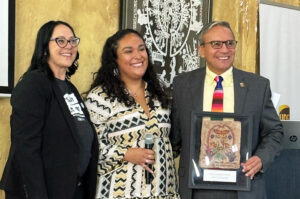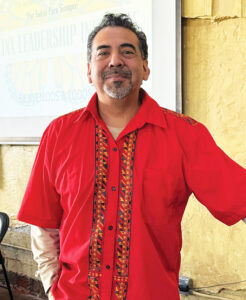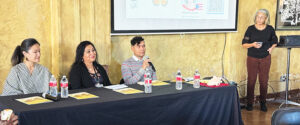The National Alliance on Mental Illness (NAMI) of Greater Toledo hosted the 10th Annual Latinx Mental Health Forum at the Sofia Quintero Art and Cultural Center on October 10, 2025. The five-hour event was well attended with community agencies represented, as well as social workers and counselors who were there to obtain their required CEUs for licensure while learning more about working effectively with the Latin clients in their community. The 13-member, planning committee was a Latin lead group following the “nothing about us without us” mantra which is so important for effective programming and meeting the needs of the people you serve.
After breakfast, the welcome and introductions, the keynote speaker, Dr. Manual Zamarripa, LPC-S, Co-founder of the Institute of Chicana/o/x Psychology, began the program. He called attendees into session by blowing into a conch shell, a tradition used by indigenous cultures. By calling us in to a deeper place inside, participants turned facing all points of the compass, north, south, east and west, as well as ground themselves to the earth as he recited words of healing and introspection. Dr. Zamarripa spoke on destigmatizing and decolonizing mental health in Chicanx/Latinx communities focusing on bringing forth cultural strengths and resources.
 Dr. Zamarripa spoke of “Brown Wellness” as being a form of resistance. Post-colonization stress from the conquest of the Spaniards of the indigenous people of Latin America is a form of PTSD; struggling with racism implies the mainstream culture is superior. He spoke of three aspects of brown culture:
Dr. Zamarripa spoke of “Brown Wellness” as being a form of resistance. Post-colonization stress from the conquest of the Spaniards of the indigenous people of Latin America is a form of PTSD; struggling with racism implies the mainstream culture is superior. He spoke of three aspects of brown culture:
- Identity-pride, self-motivation, being successful, importance of school
- Family/Community-Collectivism, interconnectedness, responsible to the larger group; be our own person, yet part of bigger group
- Spirituality-member of family or church. Not all Latin are part of religion; this is a stereotype.
Dr. Zamarripa also explained how the Latin community sees a stigma in getting treatment for mental health and then added so does the community at large. He explained that indigenous people in Mexico did not believe in a god, but in sacred energy. They also had a healer. When a person would go to the healer, it would be with family/friends there for support as they sat in a circle around a fire. One of his slides said:
Therapy is Ours
 “The art of using talk therapeutically is not solely a White people thing. Historically, ancestrally we went to our community, our elders, our circle when we had struggles or difficulties. We, in fact, used “talk” as a path to healing.”
“The art of using talk therapeutically is not solely a White people thing. Historically, ancestrally we went to our community, our elders, our circle when we had struggles or difficulties. We, in fact, used “talk” as a path to healing.”
Additionally, the Latin “ancestorial foundation” which you still see today include:
- Platica (from the verb platicar- to converse) This is not the same as is done in the dominant white culture, but has more feeling, connectedness, and supportiveness.
- Personalismo-(personable)-For example, Latins are more likely to engage in conversation, for example at the checkout line with the clerk at the grocery store, and not rush through in a hurry.
- Importance of Affect-being expressive and emoting is a regular and important part of Latin culture.
- Interconnectedness-belong to something bigger than yourself, a group, your family, community is highly valued and practiced in Latin community.
The presentations by Dr. Zamarripa were insightful and validating. For those from a minority community, the white dominant cultures’ yardstick used to measure norms, does not fit everyone. Every group has its origin of ways of being and norms which define a culture. If as a clinician, you are there to heal or treat someone, understanding someone’s culture is paramount to being an effective healer and understanding at a deeper level what they are experiencing or struggling with.
After lunch, there was singer who sang in Spanish, traditional Mexican songs. Followed by panels of those in the field discussing their work and discussing methodologies in mental health. Louis Guardiola, MSW, field coordinator, and senior lecturer at The University of Toledo, asked those in the audience to stand up if they were a clinician (e.g., social worker, counselor, etc.) Then he asked those who were Latinx to remain standing, then those who were bilingual; only three of the entire group were bilingual clinicians.
The need to learn more about our Latin roots, culture and language are paramount to successful treatment of behavioral health. At the end, Marriah Kornowa, the Executive Director of NAMI, presented a list of “Calls to Action” of upcoming events in the Latinx community. This 10th Annual Latinx Mental Health Forum did much to teach and inspire us all to do better. It was an uplifting, successful event. Plan to attend the 11th forum next year.
Colette Cόrdova has been a bilingual, licensed social worker for 31 years working in the field and later as a macro-social worker as an administrator and advocate. Prior to that she was a bilingual elementary teacher for five years teaching in Texas in the valley and in Houston.


